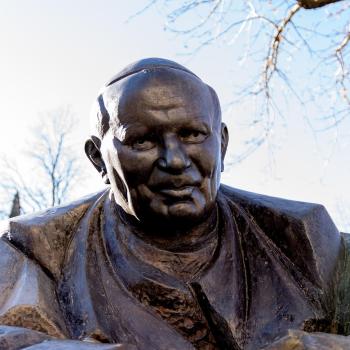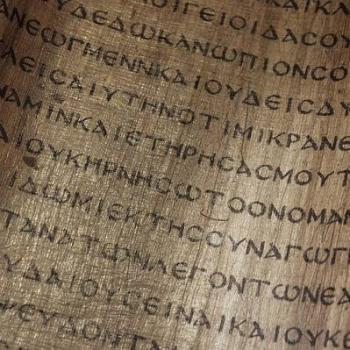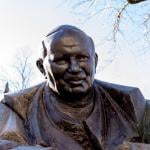RACHAEL’S QUESTION:
What is the significance of Jesus cursing the fig tree?
THE RELIGION GUY’S ANSWER:
Our discussion will focus on the Gospel of Mark (11:12-14 and 20-26) rather than the briefer parallel version in Matthew (21:18-22), which most experts think was written down later. Mark records the following:
Jesus was traveling with his disciples to Jerusalem, where he was to “cleanse” the Temple by driving out devious money-changers and sellers of birds for sacrifice. He was hungry and spotted a fig tree. Seen from the distance, it showed leaves, but close up there was no fruit. Jesus declared that no-one would ever again eat fruit from this tree. Returning from the Temple the next day the disciples saw that the tree had withered down to its roots. (Matthew puts the “cursing” after the “cleansing” and says the tree withered immediately.)
Scholarly British Bishop N.T. Wright says this narrative “looks most peculiar,” and it’s “one of the most difficult in the Gospels” in the view of D.E. Nineham at the University of London. That’s because, as Hugh Anderson of the University of Edinburgh observed, the cursing of the fig tree was Jesus’ only reported miracle of “destruction” rather than restoration, so at first glance it seems “out of character” if not “irrational.”
Interpreters see significance in Mark’s literary “sandwich” with the Temple assault enclosed within two halves of the fig tree account. It’s important to realize that the fig tree is a symbol for the Israelite nation in many Old Testament passages, an apt poetic device due to this fruit’s importance for the regional diet.
Jesus was not angry over his hunger, and certainly not angry at a tree. Rather, scholars tell us, he was filling the role of a Jewish prophet like many before him. Thus, he was proclaiming judgment against the Jewish leadership and anticipating the destruction of the Temple and all of Jerusalem, which in fact Roman troops were to carry out in A.D. 70. Jesus was also warning his followers then, and ever since, against appearing religious on the surface while in reality bearing no spiritual fruit.
Therefore, the cursing of the tree was what’s called an acted-out parable, which Jesus (and Mark and Matthew) linked with the religiously symbolic center of the people and their leadership.
Jesus himself offered another explanation alongside the implicit prophecy against spiritual barrenness. In the wake of the miraculous withering Jesus urged his followers to be bold and expect other miracles as they offered prayer requests to God — presumably not for destruction much less material rewards but for good and spiritual things.
He also told those who offer prayers to first be spiritual cleansed by forgiving anyone they have a grudge against, just as their heavenly Father forgives their own sins. This same admonition is familiar from the “Lord’s Prayer” (see Matthew 6:12 and Luke 11:4).
This brings to mind Jesus’ parable of the fig tree in Luke (13:6-9), which commentators tell us conveys the same message about spiritual emptiness.
The Nazarene taught the tale of the owner of a fig tree that had provided no fruit for three years so he tells his gardener to cut it down because it’s worthless. The gardener instead proposes taking special care of the tree for one more year, and if it still provides no fruit then he’ll get rid of it. The morals of the story: 1) Improve by carefully tending your spiritual garden. 2) God in his mercy may give you a second chance.
Other matters about the cursing:
Liberal exegetes, who don’t necessarily treat Gospel narratives as historically true, theorize that Mark turned the fig tree parable found in Luke into a literal incident. That’s an interesting theory, though there’s no basis for it in the text as it stands.
Some skeptics accuse Jesus of intending to steal fruit and then compounding that sin by destroying a tree that was not his property. Most consider that a stretch. It was considered acceptable for a Jew to take a bit of fruit if hungry, and there’s no indication this tree was in an enclosed garden tended by an owner, so it was presumably growing wild along the roadside.
More troublesome is Mark’s phrase that there was no fruit because “it was not the season for figs.” Every Jew would have known this, Jesus included. Commentators who’ve lived in the Holy Land explain that around early April — the likely time this occurred because Jesus’ crucifixion soon followed — the fig tree bears small green fruit that’s edible if you’re hungry enough, with fully ripe fruit coming in June. These first fruits may appear even before leaves do, so when Jesus saw the leaves he’d naturally expect to find fruit.
A final point of theological importance: Since Jesus experienced hunger, this underscores the orthodox belief that although he was the Son of God he was also truly and fully human. That counteracts the later heresies of Docetism and Gnosticism that emphasized Jesus’ divinity to the exclusion of his humanity.












